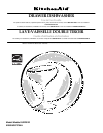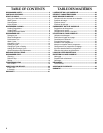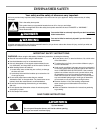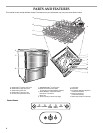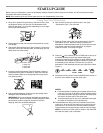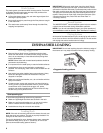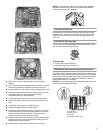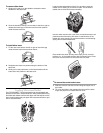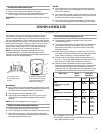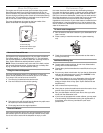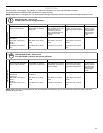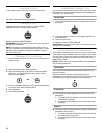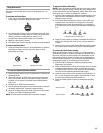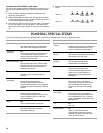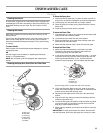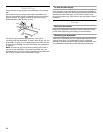
9
To install the center basket cover
1. Insert a cover hinge end into holder on one side.
2. Slide the cover until you can insert the opposite hinge end
into the holder on the other side and slide into place.
IMPORTANT: Always load items (knives, skewers, etc.) pointing
down.
NOTES:
■ Do not load silver or silver-plated silverware with stainless
steel. These metals can be damaged by contact with each
other during washing.
■ Some foods (such as salt, vinegar, milk products, fruit juices,
etc.) can pit or corrode silverware. Run a rinse cycle if you do
not have a full load to wash immediately.
■ Check the bottom of the silverware basket to ensure items
have not come through as they may stop spray arm rotation.
DISHWASHER USE
Detergent Use
The detergent and rinse aid dispenser is located on the front
inside wall of the drawer. The detergent dispenser has two
sections, the pre wash section is the smaller and the other is for
the main wash detergent. The pre wash and main wash sections
both have inside fill line markings. The pre wash section has one
marking which represents 1 tsp (5 mL). When it is full, it holds
2 tsp (10 mL). The main wash section has two markings, the
lowest mark indicates 2 tsp (10 mL), the middle mark 4 tsp
(20 mL), and when it is full it contains 6 tsp (30 mL).
NOTE: The detergent dispenser is designed for use with
powdered detergent. Liquid and tablet detergents are not
suitable to be used in the dispenser. (Posts inside dispenser are a
reminder not to use detergent tablets.)
IMPORTANT:
■ Use powdered, automatic dishwashing detergent only. Other
detergents can produce excessive suds that can overflow out
of the dishwasher and reduce washing performance.
■ Add detergent just before starting a cycle.
■ Store tightly closed detergent in a cool, dry place. Using
fresh, automatic dishwasher detergent results in better
cleaning.
NOTE: Do not use detergent with a rinse cycle.
Filling the powdered detergent dispenser
1. Press the latch down and the door will open.
2. Pour in detergent. No detergent is needed for the Rinse cycle.
3. After filling the section(s), close the dispenser door until it
clicks shut. The detergent will automatically be released into
the drawer during the wash cycle.
How much powdered detergent to use
■ The detergent quantities suggested in the chart are for
individual drawer use.
■ The amount of detergent to use depends on the hardness of
your water and the type of detergent. If you use too little,
dishes will not be clean. If you use too much in soft water,
glassware will etch.
■ Water hardness can change over a period of time. Find out
your water’s hardness by asking your local water department,
water softener company, or county extension agent.
■ You can order, at no charge, a water hardness test strip. In
the U.S.A., call the Customer eXperience Center and ask for
Part Number 4171690. (See “Assistance or Service.”)
■ Different brands of dishwasher detergent have different
amounts of phosphorus for softening water. If you have hard
water and use a detergent with a phosphorous content of
less than 8.7%, you might need to use more detergent, or use
a detergent with a phosphorous content higher than 8.7%.
*tsp = teaspoon. 1 tsp = 5 mL.
**No detergent is required in pre wash section for the Quick
Clean and Light/China cycles.
A.Pre Wash section
B.Main Wash section
C.Posts
D.Detergent dispenser latch
E.Rinse aid dispenser plug
F. Rinse aid indicator light
G.Water inlet opening
A
B
C
D
E
F
G
Water Type Wash
Cycles
Detergent
Quantities
Pre
Wash
Main
Wash
Hard
(13 grains per U.S. gallon
or above)
All** 2 tsp*
(10 mL)
6 tsp*
(30 mL)
Medium
(7-12 grains per U.S. gallon)
All** 2 tsp*
(10 mL)
4 tsp*
(20 mL)
Soft
(0-6 grains per U.S. gallon)
Heavy
Normal
Quick
Clean
Light/
China
1 tsp*
(5 mL)
1 tsp*
(5 mL)
3 tsp*
(15 mL)
2 tsp*
(10 mL)
1 tsp*
(5 mL)
1 tsp*
(5 mL)



